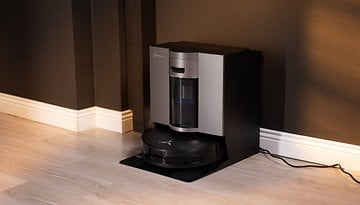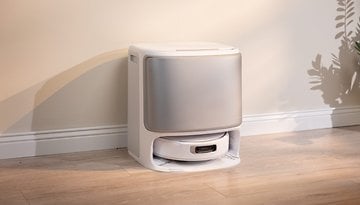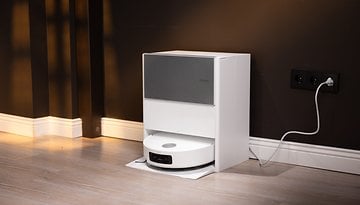Oukitel P5000 Review: 5 kWh Power Station to Go
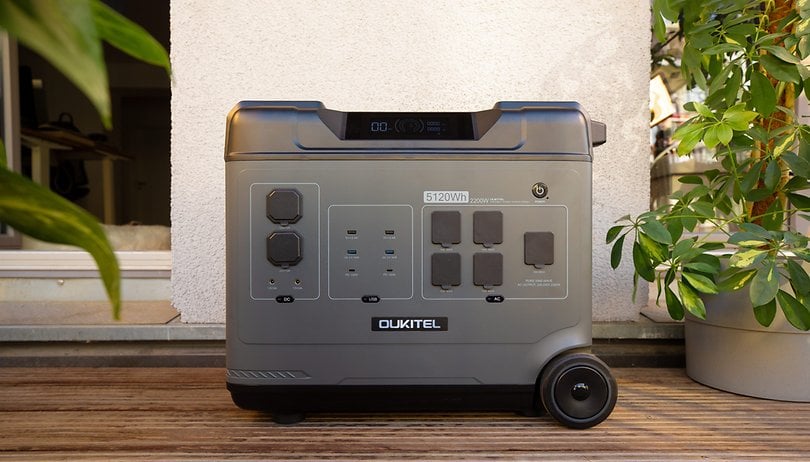

If the name Oukitel is still unknown to you, this will change with the P5000. The mega power station has a whopping 5,120 Wh up its sleeve and can supply a frugal household with energy for several days. Despite the hefty weight of 52 kg, transport is relatively unproblematic thanks to the rolling case design. nextpit tested whether the Oukitel P5000 can keep up with power stations from Bluetti, Ecoflow, Jackery & Co. in terms of efficiency and performance.
Good
- Practical rolling case design
- Great screen
- High capacity of 5.12 kWh
- Convincing efficiency
- Up to 4,000 W output power at peak
Bad
- No supporting app
- Carrying handle does not make the most stable impression
- Very loud in operation
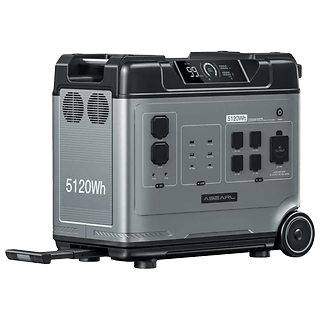
Oukitel P5000 release date and price
Whether as a buffer for your island system or as a portable power source for your next adventure—the Oukitel P5000 convinces in many areas and offers a huge capacity of 5,120 Wh as well as an output power of up to 4,000 W at peak. If that's not enough arguments for the mega power station, the P5000 comes rolling around the corner with a competitive efficiency of 78%.
Thanks to the case-like design, the transport is also as "light" as it gets with a combat weight of 52 kg. However, Oukitel has unfortunately omitted a supporting app. With a price of $2,999, the Oukitel P5000 is certainly not the cheapest power station, but it offers an enormous amount of performance and has no serious weaknesses to show.
This article is part of a cooperation between nextpit and Oukitel. This cooperation has no influence on the editorial opinion of nextpit.
Design and connections
Even though the Oukitel P5000 weighs a whopping 52 kg, it is easy to transport thanks to the case design. All necessary cables are stored in the integrated box above the power station. Finally, the Oukitel P5000 is capable of powering up to 15 devices simultaneously.
Pros:
- Integrated compartment for cables.
- Easy transport thanks to case design.
- Numerous connections.
Cons:
- -
Ouki Who? I have to admit, until the Intersolar trade show in Munich, Germany, the Chinese manufacturer was unknown to me as well. And now, a short time later, I find myself optimistically trying to free a 52 kg behemoth from its box. No need to panic, my back is fine—let's rather take a look at the Oukitel P5000 with 5,120 Wh. You haven't misread—five thousand one hundred and twenty watt-hours!
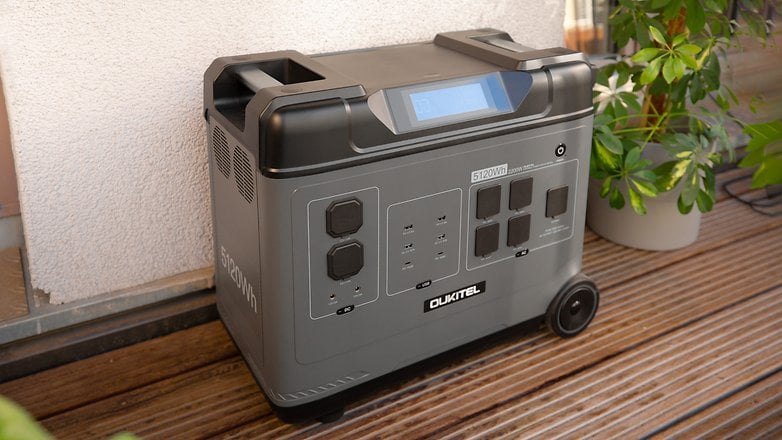
Once you have the Power station in front of you, you will quickly notice the case design of the portable power source. Thanks to two wheels and an extendable handle, transporting the Mega Power station is easy and comfortable.
The telescopic handle doesn't make the most stable impression when lifting the power station. You should rather not use the handle to lift it over a step, but the Power station really rolls smoothly on even ground.
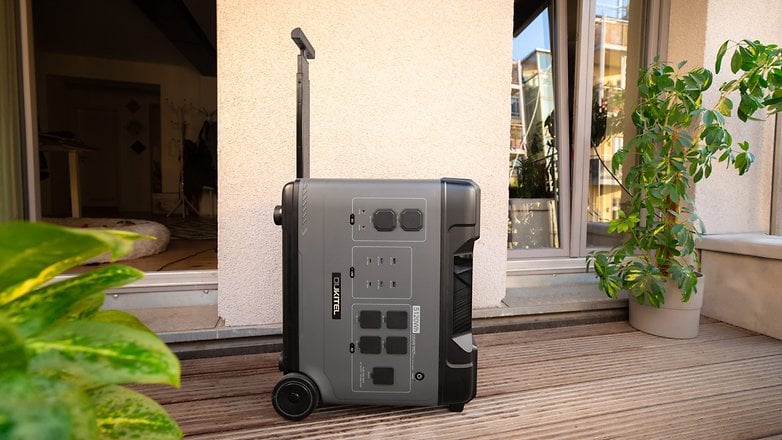
Two side handles are available on the 55 × 29.5 × 48.7 cm Power station for stairs and the like—your back will thank you if you carry the Power station in pairs. And what about the cables?
You don't have to worry about them at all, because Oukitel has integrated a box into the top of the Power station, where you can safely store all the necessary cables. I particularly like the fact that the box has a push-to-open mechanism, and Oukitel has not installed an additional handle that would harm the simple design.
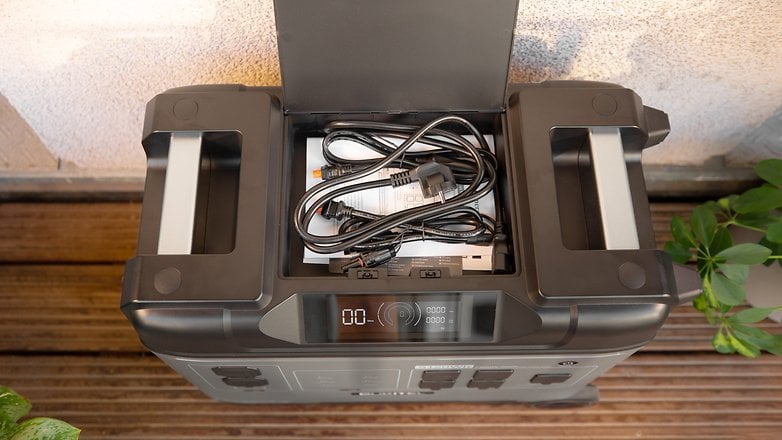
Speaking of cables: The scope of delivery includes a solar charging cable, an adapter for PV panels, a car cable and a user manual for all emergencies. The Oukitel P5000 offers you a wide range of ports on the front:
- 5x 100-120V sockets
- 4x USB-A ports (2x 12W and 2x 18W)
- 2x USB-C ports with 100W power
- 2× 12V DC outputs
- 1x 24V DC output
- 1x cigarette lighter
Only the USB ports are not protected with a cover. On the back, you'll find all the ports to power the power station. You can charge the P5000 with power from an earthed socket, a solar panel or your car. Solar charging is especially interesting, because the P5000 consumes up to 1,000 W here. You can read about the advantages for you in the performance section of this review.
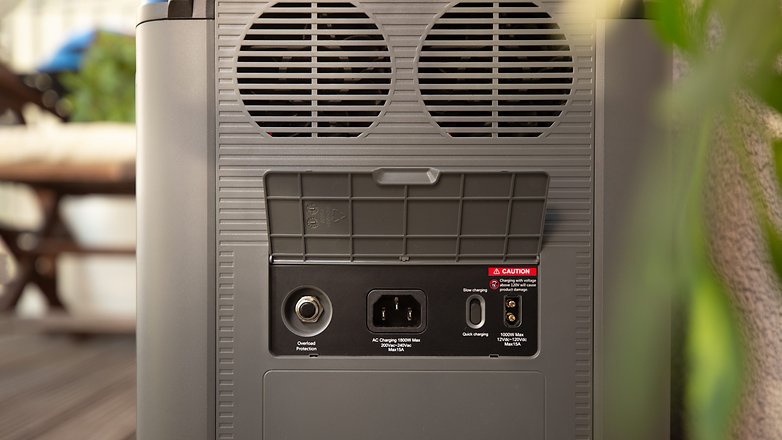
Finally, there is a wide and, in my eyes, excellently placed screen on the front. This acts as your information center. Here you can see the input and output power, the battery status and how long the charging process will last, respectively how long the supply of the connected consumers is still possible. Last but not least, there are large but inconspicuously placed vents on the sides.
Performance
The Oukitel P5000 stores a good 5 kWh and is an efficient power station with 78%. Unfortunately, the operation only works directly "on site" with buttons because there is no software support.
Pro:
- High capacity.
- LiFePO4 batteries installed.
- Solid efficiency of 77.
- Available UPS function.
- 24 V output for micro-inverter.
Cons:
- No app.
- Very loud during charging and discharging.
Unfortunately, Oukitel did without a supporting app. Instead, you operate the huge power station with the clear button layout. There are four buttons for control: One to turn on the power station, another to activate AC power, a button to release DC power and finally a last button to turn on the USB ports.
During the day, operation is unproblematic. However, in the wilderness, especially when operating the power station in the dark, it can be an annoying endeavor due to the lack of illuminated buttons.

In terms of capacity, the Oukitel P5000 is no match. In the practical test, the power station needs a whopping 5,973 Wh for a complete charging process. We then get 4,635 Wh out of the power station with a 1,000 W consumer in our standard benchmark.
With the resulting efficiency of 78%, the Power station easily competes with the Jackery Explorer 2000 Plus or the Fossibot F3600. The Power station loses the remaining 22% in the form of heat—and that cannot be ignored. We measured a volume of 60 dB in operation at times during the test.
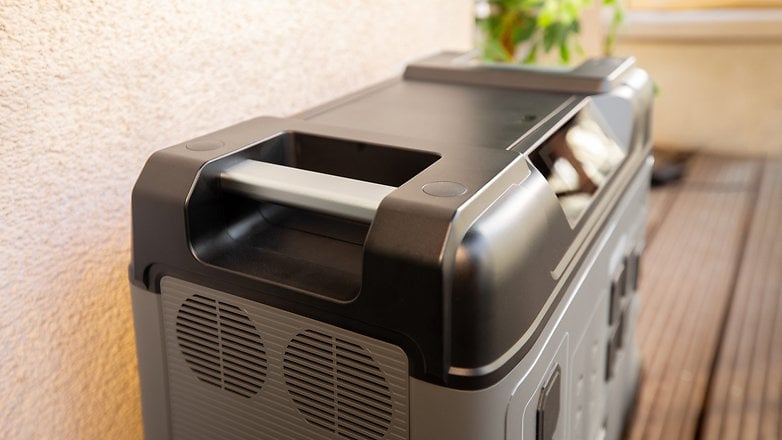
With 4,635 Wh, we're talking about a huge chunk of energy. There are numerous advantages for you. For example, you can use the P5000 as an uninterruptible power supply.
With the constant output power of 2,200 W, the power station can easily take over the supply of your household appliances in case of a power outage. If you need to power heavy equipment, that's no problem either, as the P5000 is capable of boosting the power to 4,000 W for a short time.
The Oukitel P5000 is also a viable option as a storage unit for your island-style balcony power plant, as you can charge the solar generator with up to 1,000 W of solar power. Not to forget: Included is an adapter for the XT60 port, which offers two standard MC4 connectors for your solar panel.
- Read also: Which PV module fits to your Power station
The P5000 does not have a grid-synchronous feed-in function, but it does have a 24 V DC output to which you can connect an inverter. Due to the lack of a supplied adapter cable from Aviation Port to MC4, we unfortunately couldn't try out the feature yet, but we will test it when the opportunity arises.
- Related: The best solar panels in comparison
While we're on the subject of charging: In the test, the P5000 is fully charged after just 3.5 h. Based on the high nominal capacity of 5,120 Wh, this is a pretty fast charging time. This is partly due to the available fast charging function with 1,800 W of AC charging power.
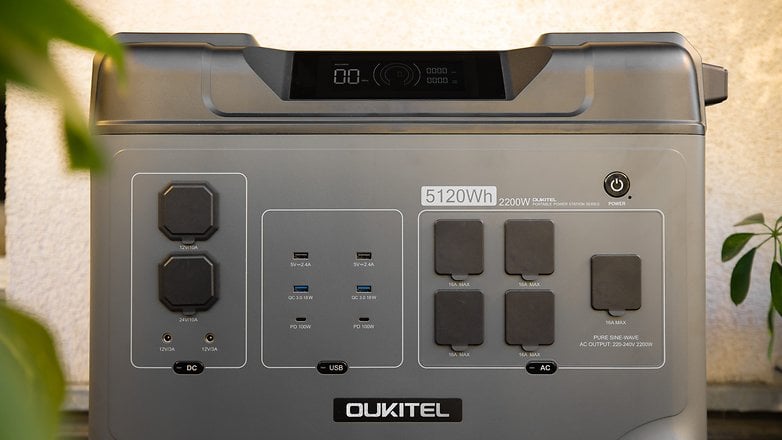
Finally, the P5000 is equipped with LiFePO4 batteries. Compared to lithium NMC batteries, lithium iron phosphate cells offer significant advantages in terms of durability and safety. Oukitel promises 80% of the original efficiency after 3,500 charge and discharge cycles.
At six complete cycles from 100 to zero and back per week, this corresponds to a full ten years. This cycle stability is especially important when you use the power station as a storage device for an off-grid system in everyday life. Last but not least, pass-through charging is also possible with the P5000.
Final verdict
The Oukitel P5000 is a massive power station with an equally massive capacity of 5 kWh. A single working field for the power station cannot be defined—and that is precisely where its strength lies in my opinion. Do you plan to take the monster camping? No problem! Thanks to the extendable handle and the wheels, transporting it is no problem if you're not sleeping in a tree house.
But even loading it into the trunk or camper is a sporty feat with a weight of 52 kg. The weight is nevertheless astonishing for a power station of this caliber. And for your home? The P5000 is also versatile there. On the one hand, the UPS function of the P5000 guarantees the supply of your most important devices in case of a power failure.
On the other hand, the Oukitel Power station with its high capacity of 5,120 kWh is an interesting option if you are thinking of setting up an island system. The power station does not have a real weakness. Only the fact that the P5000 does not get support in the form of an app leaves a bad taste in the test.
Of course, we are by no means talking about a cheap power station with a recommended retail price of $2,999. If you can do without an app control, you should definitely shortlist the Mega power station.
- Also interesting: The best power stations with solar option







